School Waste Reduction Programs
Schools and universities generate about 562,442 tons of waste each year in California. Almost half of school waste is comprised of organic materials like paper, cardboard, and uneaten cafeteria food. Much of the waste generated in the California education system is recyclable. Many school districts have been successful in improving their economic and environmental performance through the implementation of waste reduction initiatives.
Laws That Affect Schools
Laws Affecting Schools and Local Education Agencies
Mandatory Commercial Recycling (AB 341)
The Mandatory Commercial Recycling (MCR) law went into effect in June 2012 and requires public entities that generate a certain threshold of solid waste per week to reuse, recycle, compost, or otherwise divert solid waste from disposal.
Mandatory Commercial Organics Recycling (AB 1826)
Mandatory Organic Recycling (MORe) requires regulated entities to implement an organic waste recycling program to divert food waste, green waste, landscape and pruning waste, nonhazardous wood waste, and food-soiled paper waste that is mixed in with food waste.
AB 827
Effective on July 1, 2020, AB 827 supports AB 341 and AB 1826 covered generators by making recycling and organic recycling containers available to customers. Wherever recycling or organic waste is generated, a school must provide an appropriate container adjacent to the solid waste container to capture and divert recycling and organic waste. Containers must be easily accessible, visible, and clearly labeled. CalRecycle has customizable labels available for download.
Short-Lived Climate Pollutants: Organic Waste Methane Emissions Reduction (SB 1383)
Effective on January 1, 2022, schools and local education agencies will be required to prevent, reduce the generation of, and recycle organic waste. Additionally, effective on January 1, 2024, schools and local education agencies with an on-site food facility will be required to recover edible food. Information on these requirements can be found on the Short-Lived Climate Pollutants (SLCP): Organic Waste Methane Emissions Reductions website for schools and local education agencies.
Other Related School Recycling & Sustainability Laws
Public Resources Code, sections 42620-42622 requires CalRecycle to provide assistance to school districts in establishing and implementing source reduction and recycling programs, including:
- A survey of school districts on their level of program implementation
- Development of a model waste reduction program
- Training and ongoing technical and informational assistance
- Information on programs for other states and institutions
Additionally, California Education Code, sections 32370-32376, encourages each school district to establish and maintain a paper recycling program in all classrooms, administrative offices, and other areas owned or leased by the school district. These sections also encourage school districts to:
- Purchase recycled paper
- Purchase the paper with the highest percentage of postconsumer waste
- Revise procurement specifications to eliminate discrimination against recycled paper and to give preference to the purchase of recycled paper
- Eliminate the purchase of paper and paper products, which are deemed potential contaminants of the educational agency’s paper recycling program
For questions or to request assistance in setting up a districtwide waste reduction program, please contact your CalRecycle regional local assistance representative.
Administration and Personnel
Strategies for Each Department within a School District
The following pages provide specific strategies that can be implemented within each program area of a school district, and, as a result, can be incorporated into the school district’s daily operations. These strategies can also serve as the basis for developing administrative procedures for each district department to support a related district-wide waste reduction policy. Many of these strategies have been implemented by the pilot school districts in the School District Diversion Project.
District Administration: Suggestions on how to provide administrative direction and support through districtwide integrated waste management policy and administrative procedures.
Business Services: Information regarding contracting for integrated waste management services, including recycling and composting.
Facilities and Planning: Excellent resources regarding greening school district building projects, including the recycling of construction and demolition wastes. (Note: This information is part of CalRecycle’s Sustainable Green “Building” site.)
Child Nutrition/School Cafeteria: Waste reduction ideas for the cafeteria and kitchen, including “Offer Versus Serve,” food donations, recycling, composting, school gardens, and more.
Maintenance and Operations: Waste reduction suggestions for the custodial, grounds, and maintenance operations.
Personnel: Ideas for incorporating waste reduction program goals into duty statements and employee evaluations.
Purchasing: Tips on how to purchase for waste reduction and how to buy recycled and other environmentally preferable products.
Technology Services: CalRecycle’s Electronic Product Management site provides information and resources regarding reuse, recycling, and proper disposal of old computer equipment or other electronic devices.
Additionally, encourage students and teachers to gear up for each new school year with CalRecycle’s back-to-school waste prevention ideas.
Waste Prevention Ideas
Waste Prevention Ideas
Reduce Paper Waste Whenever Possible
- Allow students to submit homework on the back side of used paper.
- Duplicate handouts using both sides of paper.
- Approach school administrators about purchasing a copy machine that makes duplex copies, if your current copier doesn’t.
- Avoid printing extra handouts.
- Keep a box for various types of scratch papers (single-sided, construction, etc.).
- Bind scrap paper to use for taking notes.
- Maximize use of overhead projector and black /white board to minimize use of dittoed information.
- Place worksheets in plastic sleeves. Have students write with crayon and erase with carpet squares.
- Use erasable lap boards for classroom work.
- Place wall decorations directly on walls or bulletin boards without paper linings. Reuse wall decorations or exchange them with other teachers.
- Collect scraps of construction paper, fabric, wood, and other items to use for projects. Ask local businesses to donate materials they intend to discard or provide a list of wanted items. Also, some communities have material exchanges for art supplies where schools can get cheap or free materials. Contact your county or city recycling coordinators for information.
- There are several ways to start special projects that reduce waste inside or outside the classroom:1. Write letters to manufacturers asking them to use less packaging and design products that are more durable, repairable, and reusable.
2. Designate a “no-waste day” to see how much waste can be reduced. Teach students how to bring a no-waste lunch.
3. Investigate the feasibility of composting yard debris and cafeteria fruit and vegetable trimmings.
4. Set up a worm bin in the classroom (see the request form in the appendix to receive information on vermicomposting/composting).
5. Conduct a waste prevention poster contest. Specify that posters must be made from used materials.
Product Purchasing
- Purchase products that are easy to repair.
- Purchase durable goods.
- Purchase refillable products (e.g., pens and pencils).
- Purchase products in concentrate or bulk form. (these often have less packaging per unit of product than unconcentrated or individually wrapped items).
- Purchase products made with recycled materials.
- Purchase or make reusable displays. Borrow or trade displays with other teachers.
- Bring lunch in reusable containers, e.g., use a thermos and cloth lunch bag or lunch box. Encourage students to do the same!
- Use reusable dishware for class parties. Consider having each student keep his/her own cup, plate, and utensils for parties. Alternatively, select party foods that don’t need to be served on dishware.
- Set up a table at the end of semesters for students to place unwanted pencils, notebooks, etc. Bring the materials out at the beginning of the next semester for students to use.
Making Lapboards
You can make lap boards from masonite boards, roughly 12″ x 18″. Paint these with two coats of chalkboard paint, ‘cured’ by rubbing chalk across the board, and washed with a wet cloth. The rule-of-thumb for chalkboard paint is one pint per classroom.
Students can use old socks or carpet squares for erasers. The amount of paper saved could justify purchasing the materials. (Students could estimate the amount of paper saved over a specified period of time.)
Waste Prevention in Administrative Offices and Teacher’s Lounges
This list of waste prevention ideas from other schools is intended to help jump start your waste prevention efforts. Brainstorming with others is bound to create more ideas!
- Cut paper use where possible.
- Make two-sided copies.
- Use bulletin boards, electronic mail and/or voice mail to convey or exchange information.
- Print forms on paper which has been used on one side, such as faculty/student messages and homework requests.
- Post memos and general bulletins next to teacher’s mailboxes instead of making individual copies.
- Set up boxes to collect paper used on one side only. Reuse blank sides of paper in laser printers or as scratch pads.
- Use centralized files for hard copies instead of individual file systems.
- Reuse manila envelopes/file folders.
- Re-format faxes to omit cover sheet.
- Circulate magazines rather than buying multiple subscriptions.
- Use a half sheet of paper for short messages and memos.
- When sending notes to parents, send one per family rather than one with each student.
- Before printing, double check the number and type of copies you need (e.g., double-sided and collated).
- Replace “Post-it notes” by using reused paper and paper clipping it to documents. “Post-its” are a contaminant for recycling because of the self-adhesive strip.
- Establish policy that it is acceptable to have a few hand corrected typos on internal messages and memorandums so that copies don’t have to be redone.
- Reuse packaging and packing materials.
- Use rebuilt or refillable toner cartridges, and send used toner cartridges to a company that will rebuild or refill them.
- Use permanent tape dispensers.
- Use refillable pens and pencils.
- Send typewriter ribbons to a firm that re-inks them.
- Send postcards or call to remove your name from mailing lists.
- Buy sugar, coffee, and tea in bulk. Use reusable coffee filters (metal or cloth) or ones made from unbleached paper.
- Drink from reusable mugs. Set up storage rack for mugs.
- Bring lunch in reusable containers.
- Bring in magazines to share with colleagues.
- Keep reusable dishware on hand to use for lunch or parties.
Waste Prevention at Special Events
This list of waste prevention ideas from other schools is intended to help you jump start your waste prevention efforts. Brainstorming with others is bound to result in more ideas!
- Avoid giving away junk prizes that break easily or will be thrown away.
- Design decorations that can be reused.
- Make displays and decorations from used items and design them so they can be reused.
- Exchange decorations with other groups so they are “new”.
- Don’t release balloons into the environment. The balloons can cause problems for wildlife. For example, animals may mistake the balloons for food.
- Select a menu that eliminates the need for service ware. For example, serve sandwiches, fruit, cookies, and other finger foods.
- Use reusable table cloths, plates, cups, and utensils, if practical.
- Have everyone label their cups so they can keep track of them.
- Post agendas or program information.
- Collect programs after an event and use them again (e.g., band concert).
- Print programs and other materials using soy-based inks.
- Ask attendees to share programs or handouts.
- If name tags are needed, select ones that can be reused. Collect the tags at the end of the event and use them again. Recycle paper inserts.
- Set out clearly labeled reuse or recycling bins at an event. Arrange to reuse or recycle waste that is generated.
- Use both sides of poster board before recycling or discarding.
- Inform public about “greenness” of event and how they can contribute (e.g., bring your own plate).
Other Waste Prevention Ideas
- Waste prevention activities need support from the top! Top administrators should have a waste reduction resolution or policy that provides support for waste prevention and recycling practices to be implemented at the school.
- Provide staff training on waste prevention. Educating staff on cost savings/benefits will empower them to identify alternatives.
- Award or recognize waste prevention efforts.
- Set up monthly “No-Waste Days” where the object is to create as little waste as possible. Eventually, the event may turn into habit.
- Create PTA positions for waste prevention and recycling.
- Sponsor the sale of reusable lunch bags or lunch boxes to cut down on disposable lunch bags. Send a letter home or present information at a PTA meeting, encouraging parents to give students “no waste” lunches.
- Check to see if your area has a materials exchange for art supplies, furniture, books, or other materials. Some regions have material exchanges that sell goods inexpensively or donate them to schools.
- Set up swaps to exchange goods.
- Set up a waste display to educate students and faculty.
Grants and Funding
Grants and Funding Opportunities
The following are grants and funding programs specific to schools and the environment.
Community Composting for Green Spaces Grant
CalRecycle’s competitive grant program is provided to increase the number of community groups operating small-scale composting programs in green spaces within disadvantaged and low-income communities, and to increase the capacity of those composting programs.
Food Waste Prevention and Rescue Grant
CalRecycle’s competitive grant program assists in lowering overall greenhouse gas emissions by establishing new or expanding existing food waste prevention projects (source reduction or food rescue for people) in California by reducing the amount of food being disposed in landfills.
Reuse Grant Program
CalRecycle’s piloted a new program in fiscal year 2019-2020. Reuse is the second highest tier in the waste management hierarchy of “reduce, reuse, recycle” and plays a vital role in reducing overall waste generation. Investment in reuse is needed for waste reduction projects.
Tire-Derived Product Grant
CalRecycle’s Tire-Derived Product (TDP) Grant program promotes markets for recycled-content products derived from waste tires generated in California. Tire-derived products are used for a variety of applications, including as a playground surface and mulch (chips, bark), and storm water mitigation measures.
Clean Mobility in Schools
The California Air Resources Board’s Clean Mobility in Schools (CMiS) is a pilot grant program that supports a variety of projects promoting zero-emission transportation options for students, parents, and staff members. CMiS is part of the Clean Transportation Equity Projects.
Clean School Bus Replacement Program
The California Air Resources Board offers several financial incentives to increase the number of clean school buses in operation and to drive the development of cleaner technologies by speeding up their adoption by school fleet owners.
Farm to School Grants
The U.S. Department of Agriculture’s annual competitive grant program supports planning, developing, and implementing farm to school programs and activities. USDA’s Farm to School grants are an important way to help state, regional, and local organizations as they initiate, expand, and institutionalize farm to school efforts.
Coca-Cola Recycling Bin Grant
A grant partnership between Keep America Beautiful and Coca-Cola Foundation to support recycling in communities by providing bins to expand recycling opportunities in public spaces.
Waste Reduction Grants
StopWaste offers a range of grant opportunities on an annual basis to both non-profits and businesses, aimed at increasing individual, business, and community involvement in the reduction of waste in Alameda County.
Award and Recognition Programs
Award and Recognition Programs
The following are environmental award and recognition programs with non-profit organizations and partners for schools.
Green Ribbon Schools Award Program
In conjunction with the US Department of Education, the California Department of Education (CDE) is implementing a Green Ribbon Schools Award Program. This program recognizes schools that are taking a comprehensive approach to greening their school.
California K-12 Schools Recycling Challenge
The California Recycling Challenge is a friendly competition and benchmarking tool for K-12 school recycling programs to promote waste reduction activities to their school communities. The Recycling Challenge for 2021 will include the recycling challenge, a recycling art contest, and litter analysis using Keep California Beautiful’s Environmental App.
US EPA’s Food Recovery Challenge
As part of US EPA’s Food Recovery Challenge, schools pledge to improve their sustainable food management practices and report their results. To register your school as a participant, complete and submit online application form. The list of participants, including K-12 Schools, college, and universities, is updated quarterly.
California School Boards Association Golden Bell Awards
The CSBA Golden Bell Awards promotes excellence in education and school board governance by recognizing outstanding programs and governance practices of school boards in school districts and county offices of education throughout California. Golden Bell Awards reflect the depth and breadth of education programs and governance decisions supporting these programs that are necessary to address students’ changing needs. The program includes an Sustainable, Renewable, Energy and Resource Efficient Programs category.
Presidential Innovation Award for Environmental Educators
The Presidential Innovation Award for Environmental Educators recognizes outstanding kindergarten through grade 12 teachers who employ innovative approaches to environmental education and use the environment as a context for learning for their students. The White House Council on Environmental Quality, in partnership with the U.S. EPA administers this award to honor, support, and encourage educators who incorporate environmental education in their classrooms and teaching methods
President’s Environmental Youth Award
The President’s Environmental Youth Award (PEYA) recognizes outstanding environmental projects by K-12 youth. The PEYA program promotes awareness of our nation’s natural resources and encourages positive community involvement. Since 1971, the President of the United States has joined with EPA to recognize young people for protecting our nation’s air, water, land, and ecology.
Go Green Initiative
The Go Green Initiative is a global environmental education program that trains teachers and volunteers in schools to conserve natural resources for future generations and protect human health through environmental stewardship. We provide free and continual instruction for volunteers in all 50 U.S. states and 73 countries, teaching them to integrate environmental education into existing curriculum and quantify the environmental impact of their conservation efforts.
Eco-Schools USA
National Wildlife Federation’s Eco-Schools is an internationally acclaimed program that provides a framework to help educators integrate sustainability principles throughout their schools and curriculum.
Ten Strands
Ten Strands weave stakeholders and strategies together into strong, focused education partnerships, with the goal of raising environmental literacy by providing high-quality environment-based learning and hands-on education to all California K-12 students.
The California Center for Civic Participation (Cal Center)
The Green Focus program examines some of California’s most influential environmental laws while introducing students to the green career sector. Cal Center’s goal is to familiarize Sacramento youth with the scope of California environmental policy and its influence on the green career field and the rest of the nation.
BCK Programs, LLC: Environmental Education
BCK’s programs align with the environmental objectives that school districts and municipalities, along with regional and state authorities are required to complete. Through their educational programs, students become involved in accomplishing these requirements while learning job skills, improving their school site and making a meaningful impact in their community.
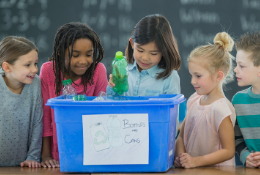
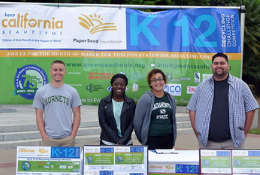
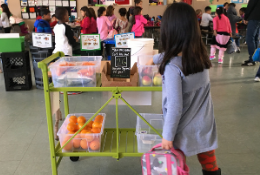
The U.S. EPA food recovery hierarchy helps schools prioritize how to handle food waste.
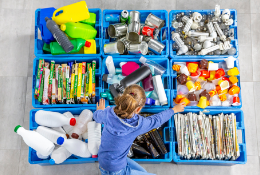
Learn more about the types of materials a school generates to identify opportunities to reduce waste and recycle more.
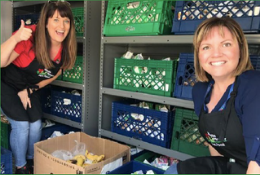
Information intended for school purchasing agents and officers to facilitate the implementation of environmentally preferable purchasing (EPP) practices throughout the school district.

Information intended for school purchasing agents and officers to facilitate the implementation of environmentally preferable purchasing (EPP) practices throughout the school district.
For more information contact: Schools Program, schools@calrecycle.ca.gov.

